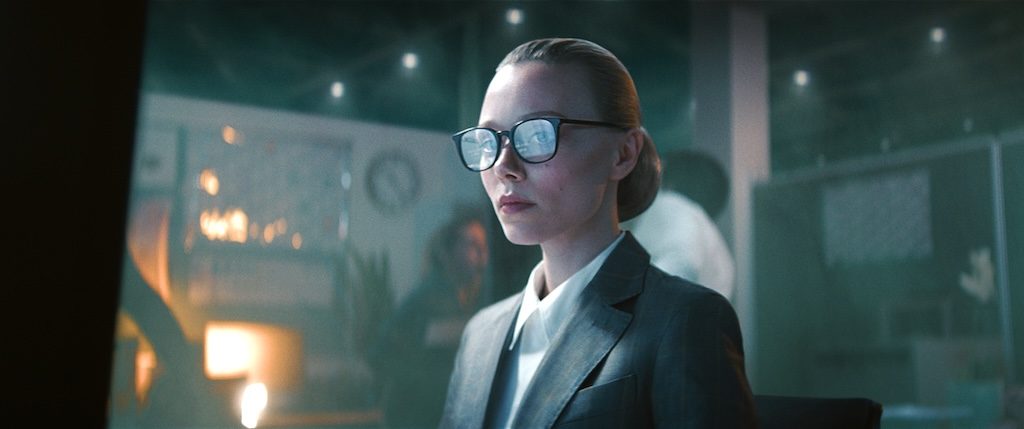Megan Impossible: Gerard Johnstone Talks “M3GAN 2.0”

What began as a pulpy, killer-doll horror movie quickly evolved into a pop culture moment—and now, a franchise with philosophical heft. The campy doll with the pristine dress returns for more murderous horror, comedy, sci-fi fun.
M3GAN‘s director Gerard Johnstone also returns for M3GAN 2.0, the highly anticipated sequel that doesn’t just double down on its horror, but dives deeper into the allegory of AI, parenting, and emotional attachment to non-humans.
Writer/ Director Gerard Johnstone discusses shaping Megan’s moral code, creating villainous empathy, and why horror-comedy only works when you take it seriously. Johnstone unpacks the evolution of Megan, why her innocence is scarier than her strength, and how the most effective horror stories often have the emotional beats of a family drama—only with more blood.

Gerard Johnston. Photo by Elizabeth Weinberg
“In the first movie, clearly Megan was a villain. But at the same time, she was a piece of software and an operating system,” Johnstone says. In the M3GAN sequel, he didn’t want to explore the corruption of Megan’s moral code because she was becoming more human-like. He also didn’t want Megan to transform into full self-awareness. She was still driven by her programming.
I was far more interested in her as a piece of technology than her as a killing machine
MEGAN vs. MEGAN 2.0: From Code to Conscience
For Johnstone, the key to M3GAN‘s success wasn’t just her sleek silhouette, snappy banter, or homicidal instincts—it was her unwavering “intentions.”
“Megan was never evil for evil’s sake,” he asserts. “Everything she did was in service to her primary objective: to protect Cady (Violet McGraw).” She can’t understand why Gemma wants to kill her because she believes she’s doing the right thing.
By portraying Megan as a literal machine executing instructions, Johnstone avoids the tropes of malevolent AI. That ambiguity, that “almost-but-not-quite consciousness,” turned Megan into an unlikely anti-hero.
“In M3GAN 2.0, we wanted to flip the lens,” the director continues. “If Megan was a misunderstood protector, what does that make Gemma? She created something to protect Cady, ignored it, and then tried to kill it when it disobeyed her. From Megan’s perspective, that’s betrayal.”
This pivot reframes the first film’s villain as a victim of neglect and explores the morally gray areas of responsibility in AI parenting. So, from a simple killer doll, an impactful social commentary about technology and humanity emerges.
Johnstone didn’t want to create a new “satanic panic.” He wanted to look at the same character and events through a different lens.
Amelia, M3GAN’s Villain and Dark Soul
Every great anti-hero needs a foil, and in M3GAN 2.0, that role belongs to Amelia (Ivanna Sakhno) —a military-engineered counterpart raised, not with love, but with singular lethal intent – a Terminator of sorts. Amelia was James Wan’s brainchild who he developed with screenwriter Akela Cooper.
“She’s what Megan could’ve become if she’d grown up differently,” says Johnstone. “It’s like a psychological case study of nature vs. nurture, just with smarter murder machines.” Amelia isn’t just Megan’s enemy—she’s her existential mirror, and their dynamic probes deep questions about autonomy, loyalty, and belonging.
“The tragedy is that Amelia wants a family just like Megan. But her path has taught her only distrust and violence. And when she tells Megan, ‘They’ll never accept you,’ it hits hard,” Johnstone emphasizes.

Ivanna Sakhno as Amelia in M3GAN 2.0, directed by Gerard Johnstone
The Art of the Sequel: Bigger Scope, Tighter Story
When Johnstone came aboard the second film, he inherited the concept of Amelia from Blumhouse, Akela Cooper, and James Wan, but rebuilt nearly everything else. “My instinct was to take Megan out of toys and into the military-industrial complex,” he states. That ambition ran into budget realities quickly. “The first draft was huge—expensive with many plot points. So the work became, ‘How do I preserve these ideas and distill them into something emotionally resonant and executable?’”
The result is a sequel that expands the thematic scope while threading individual arcs for every major character—including Katie, Gemma (Allison Williams), Megan, and even Amelia. Alton Appleton, the tech bro played by Jemaine Clement, extolls the perils of ignoring the possibility of the technological marvel of AI going rogue.
Horror, Action, Comedy—and Megan Impossible
Johnstone doesn’t view M3GAN 2.0 as just a horror film. It’s a hybrid beast: part satire, part action-thriller, part buddy comedy, especially when Gemma teams up with Megan to combat Amelia. “I see this one as ‘Megan Impossible,’ he jokes. “It’s got heist elements, espionage, a Bond-style flair—and those quiet, eerie moments where you descend into Megan’s lair like it’s Dracula’s castle.”
Despite the tonal levity and playfulness of the film, Johnstone takes the horror seriously. “Comedy only works if you commit. I write these scenes from Megan’s point of view. To her, it’s not funny—it’s heartfelt. That’s why the audience laughs. They’re reacting to how deeply she believes her own logic.” Much like a child protecting their doll.
Johnstone believes Megan is an extension of the Annabelle dolls; the difference being that she can talk and make her feelings known.
Parenting Allegory, Not Alarmism
Johnstone is clear: M3GAN 2.0 is not a cautionary tale—it’s an allegory. “We’re not saying, ‘Don’t build AI.’ We’re asking, ‘What happens when you don’t train it right?’” The metaphor of AI as a child underscores both films. Megan is a reflection of her creator’s care—or lack thereof. “You don’t train kids like dogs. You raise them. That’s the same with AI.”
This elevates M3GAN 2.0 beyond the typical horror genre scares. It’s a meditation on modern parenthood, emotional literacy, the grief of being an orphan, and the terrifying possibility that machines might not just mimic love—but crave it.
On Craft and Collaboration: Akela Cooper, James Wan, and the Story Engine
The creative triangle of Akela Cooper (screenwriter), James Wan (producer), and Gerard Johnstone is unusually organic.
“Akela had already nailed a script with the first M3GAN,” says Johnstone. “My job was to add my flavor—leaning into the allegory, the parenting subtext, and Megan as a technological marvel.”
For the sequel, Wan pitched Amelia, Cooper developed it, and Johnstone rewired the narrative from the ground up. “What I brought was the structure and themes to the foundation,” he states. “This wasn’t just a kill-fest. Every scene had to answer: What does Megan want? What is she learning?”
Writing, Breaking In, and Having Fun
Asked what advice he’d give to writers trying to establish a screenwriting career today, Johnstone candidly quotes William Goldman’s Advertures In The Screen Trade. “Nobody knows anything. The industry’s always in flux. It always feels like nothing’s getting made. Everyone’s scared. That’s not new. Movies are always being made.”
His strategy? Persistence and joy. “Your first draft will suck. Everyone’s does. The job is to push through. Rewrite. Discover. And most of all, have fun. Because fear is a creativity killer.”
Gerard Johnstone personally identifies most with Megan’s character – not because he’s homicidal – but because he wants to belong.
Join the Discussion!
Related Articles
Browse our Videos for Sale
[woocommerce_products_carousel_all_in_one template="compact.css" all_items="88" show_only="id" products="" ordering="random" categories="115" tags="" show_title="false" show_description="false" allow_shortcodes="false" show_price="false" show_category="false" show_tags="false" show_add_to_cart_button="false" show_more_button="false" show_more_items_button="false" show_featured_image="true" image_source="thumbnail" image_height="100" image_width="100" items_to_show_mobiles="3" items_to_show_tablets="6" items_to_show="6" slide_by="1" margin="0" loop="true" stop_on_hover="true" auto_play="true" auto_play_timeout="1200" auto_play_speed="1600" nav="false" nav_speed="800" dots="false" dots_speed="800" lazy_load="false" mouse_drag="true" mouse_wheel="true" touch_drag="true" easing="linear" auto_height="true"]










You must be logged in to post a comment Login